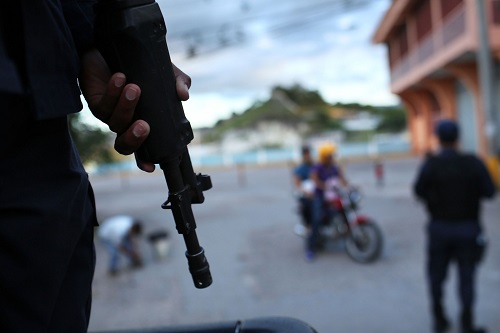AFP photo
By
Ricardo Swire
Extortion is a very lucrative business in Central America’s Northern Triangle. For regional security purposes this area is divided in two sectors. The perilous first section is the Northern Triangle comprised of Guatemala, Honduras and El Salvador. On the southern part of the isthmus are Nicaragua, Panama and Costa Rica. Often forgotten as part of the Northern Triangle is Caribbean Community (CARICOM) member Belize that shares a two hundred and sixty-six kilometre border westward with Guatemala. Belize sits on a key trafficking route, between Mexico and the Caribbean, frequently utilized for cocaine shipments originating from South America.
Patterns highlighted how Guatemalan drug kingpins also use Belize as a tropical “hide-out. ”Counter-narcotics agents’ interception and detention of top illegal narcotics executive “El Loco,” a close business associate “El Gordo” senior member of Mexican drug cartel Los Zetas, demonstrated Belize’s reputation. Exploitation schemes are the lifeblood of “Maras” or criminal gangs entrenched in Guatemala, Honduras and El Salvador. Rapid urbanisation, flawed democratic development, transnational drug trade activity and state-led repression are outstanding causes of brutal violence.
One United Nations Office on Drugs & Crime (UNODC) report quantified Mara members at twenty thousand in El Salvador, twenty-two thousand in Guatemala, twelve thousand in Honduras. Cases of extortion in Honduras were so extreme the Chamber of Commerce stopped publishing its members’ registry for security reasons. Eighty percent of Guatemala’s extortions are coordinated from within the local prison system. Fifty-four thousand archetypal structured, tattooed youths cause Central America serious national security frustrations. Salvadorian and Honduran enforcement officials have classified Maras as “terrorist groups.”
On November 14, 2016 El Salvador, Guatemala and Honduras established a “Tri-National Force” focused on disrupting Mara members’ movements across six hundred kilometres of national borders. The combined police, military, intelligence, immigration and customs team was strategically based in the western department of Ocotepeque, which uniquely shares tri-state borders. But an ever-presence of extortion bazaars in poor urban communities had already converted the Northern Triangle’s criminal economy to an unofficial employment agency for women.
CARICOM intelligence officials red-flagged the period South American Maras began including female participants in extortion schemes. Quetzaltenango Prison in western Guatemala accommodates several such female extortionists, linked either to the Barrio 18 or MS-13 gangs. In 2014 three hundred and eighty-two Guatemalan female prisoners were jailed for extortion, compared to seven hundred and ninety-one in 2017. Female extortionists represented one third of two thousand, six hundred and twelve incarcerated women.
El Salvador’s national program “Iron Fist,” plus Guatemala’s “Sweep-Up Plan” and “Zero Tolerance” in Honduras were attempted regional countermeasures. The United States’ “Plan of the Alliance for Prosperity” focused on Central American migrant flow reduction. Observed patterns outlined multiple US deportations to Central America that greatly influenced the upsurge in Northern Triangle gang crimes. 2014 was the year migrant Northern Triangle children flooded the US border.
Next-door neighbour Mexico immediately modified checkpoints, increased detentions and deportations of Northern Triangle nationals on its southern border with Guatemala. Barrio 18 and MS-13 habitually harass local businesses for “protection” payments. Such intimidation reaffirms the gang’s power. The activity also demonstrates control over underprivileged city enclaves, while generating salaries for gang members. Evidence characterized Maras as both victims of extreme social inequity and orchestrators of brutal violence.
The mafia of the poor’s top tier has realized women are “less visible” to anti-gang police scrutiny. Barrio 18 and MS-13 members target select local females and either charm or con them to use personal bank accounts to receive extortion payments. The accomplices withdraw victims’ cash and deliver it to their gang handler. Extortion serves as the economic engine that powers Central American Maras. Such intimidation activity represents the largest share of the organized criminal gang’s income. Statistics tabulate extortion payments directly cost businesses in El Salvador alone a minimum US$756 million yearly.
Ricardo Swire
Ricardo Swire is the Principal Consultant at R-L-H Security Consultants & Business Support Services and writes on a number of important issues.



No Comments Yet!
You can be first to comment this post!